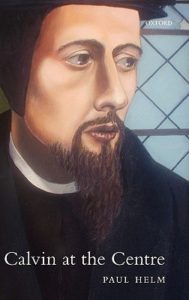 In my earlier post, Problematic Methodological Premises of “Calvin against Calvinists” Scholarship, I noted that Calvin placed providence and predestination together in book 3 of the Institutes of 1539. Calvin’s decision arose from his preaching and pedagogical interests, as evidenced by his French Catechism (1537), but he was probably influenced by Paul’s teaching of the “ordo salutis”. Richard Muller explains: “In the 1539 Institutes, Calvin shifted the credal discussion forward and placed a revised order of repentance, justification, the testaments, and predestination (now juxtaposed with providence) after his exposition of the creed—and the best explanation for this arrangement remains his accommodation to the Pauline ordo modeled on Melanchthon.” [Richard Muller, The Unaccommodated Calvin (Oxford UP, 2000), p. 136] However, in the final edition of the Institutes (1559), Calvin separated providence from predestination by moving providence to book 1 while leaving predestination as it was in book 3.
In my earlier post, Problematic Methodological Premises of “Calvin against Calvinists” Scholarship, I noted that Calvin placed providence and predestination together in book 3 of the Institutes of 1539. Calvin’s decision arose from his preaching and pedagogical interests, as evidenced by his French Catechism (1537), but he was probably influenced by Paul’s teaching of the “ordo salutis”. Richard Muller explains: “In the 1539 Institutes, Calvin shifted the credal discussion forward and placed a revised order of repentance, justification, the testaments, and predestination (now juxtaposed with providence) after his exposition of the creed—and the best explanation for this arrangement remains his accommodation to the Pauline ordo modeled on Melanchthon.” [Richard Muller, The Unaccommodated Calvin (Oxford UP, 2000), p. 136] However, in the final edition of the Institutes (1559), Calvin separated providence from predestination by moving providence to book 1 while leaving predestination as it was in book 3.
Some scholars suggest that Calvin separated providence from predestination because he had concerns that some theologians may subsume predestination under “decretal soteriology” in the name of logical deduction. However, such concerns seem unlikely for Calvin since his soteriology was developed not on the basis of logical deduction but arose from a close reading of the bible as God’s revelation.
A more plausible explanation for Calvin’s decision to separate providence and predestination is found in his debate with Pighius. Calvin criticized Pighius’ Ten Books on Human Free Choice and Divine Grace (1542) for confusing the issue of human choice and sin (treated in the first six books) and the issue of human choice and divine providence (treated in the last four books).* Arising from the debate, Calvin concluded that it is better to separate providence from predestination. Paul Helm explains,
…the potential confusion (which in Calvin’s view Pighius maliciously exploits) arises over two kinds of necessity: the necessity with which what God wills happens, and the fact that men and women in bondage to sin perform sinful actions necessarily—sinful actions being the outcome of the sinful habitus of the soul, an accidental property of the soul the existence of which is due to the Fall… Because there are two issues regarding human freedom and necessity, one pertaining to the nature of human choice as such (an issue properly to be discussed as part of God’s providential rule over his animate and inanimate creation, where Calvin distinguishes divine providence from pagan notions of chance and fate) and the other to human choice as bound in sin and freed by grace (issues to be discussed as part of soteriology), I suggest that Calvin came to think that it was wiser to physically separate his treatments of them. [Paul Helm, Calvin at the Centre (Oxford UP, 2010), p. 136]
Hence, Calvin in the final edition of the Institutes (1559) decided to place providence under the doctrine of God (book 1) and predestination under the doctrine of soteriology (book 3).
——————
* See my next post: Calvin on Self-Determination, Necessity, and Free Choice of the Will